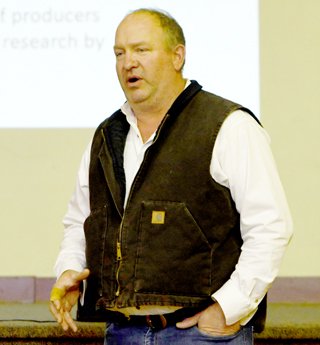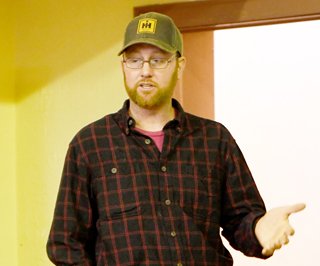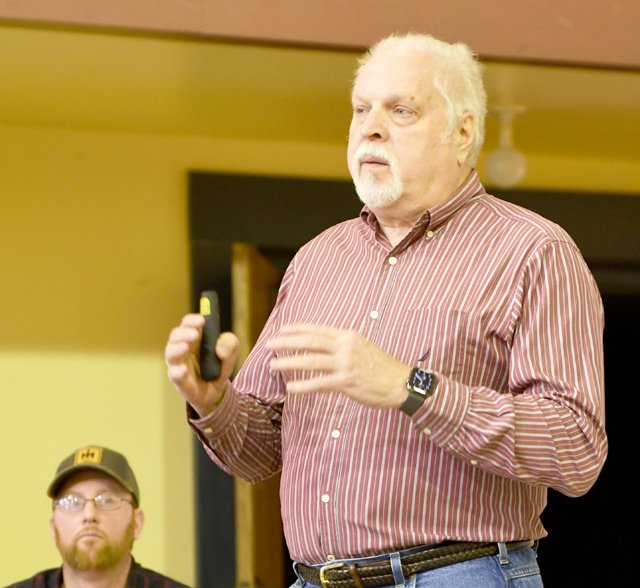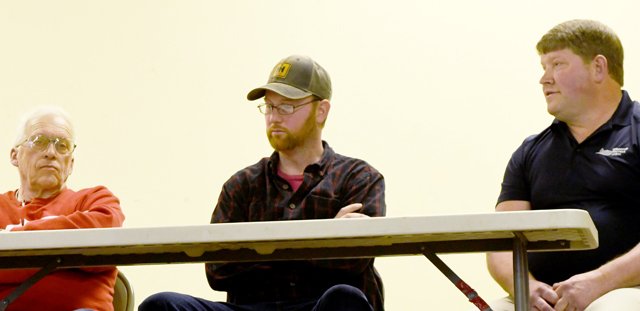CASHTON - It’s no secret that there are a lot fewer dairy farmers in America’s Dairyland these days, than there used to be. In the late 1990s, there were 20,000 dairy herds in Wisconsin, and today that number has fallen to under 6,500, with fewer than 30,000 dairy farms remaining in the entire United States. Further, the average age of the dairy farmer is 62 to 65 years of age.
Both Wisconsin Farm Bureau (WFB) and Wisconsin Farmers Union (WFU) have taken on the challenge of exploring ‘how to revitalize dairy’ in recent years. Both groups have been fostering dialogue, debating different models, and consulting with experts in the UW-System since about 2015. That was the year sky rocketing farm bankruptcies and exits began to grab the attention of the nation, with Western Wisconsin at the forefront of the trend.

“Between 2015 and 2020, the United States lost one-third of all remaining dairy farms,” Buffalo County Farm Bureau dairyman Joe Bragger said. “At this time, Wisconsin is losing one-to-two dairy herds every day.”
In 2018, WFU had conducted a five-city tour featuring Ralph Dietrich, Dairy Farmers of Ontario (DFO) Board Chairperson, and Murray Sherk, DFO Board Vice Chairperson. The purpose of the tour was to educate Wisconsin producers about Canada’s dairy supply management program.
“There’s been a lot of talk in the farming community since 2018 about the Canadian model of supply management, and whether that would work here in the United States,” Vernon County Farm Bureau organic dairyman Travis Klinkner said. “The problem that I see with the model is that the requirement to purchase quota is too much of a barrier to young farmers wanting to enter the business.”
Klinkner said that no program is ever going to make everyone completely happy, and it is difficult to find a system that works for both small and large farms. But I know that farmers, processors and consumers want stability in dairy, and I believe that in order to achieve that, we must put controls on dairy supply.
Wisconsin Farm Bureau took their own approach to pursuing solutions to the problem, and former state board president Joe Bragger described a series of resolutions adopted at the state level. In 2018, the members adopted a resolution stating “we are willing to consider a dairy supply management system.”
In 2019, they went further, expressing support for research and development of dairy growth management and other systems that increased dairy industry stability and producer profitability. This resolution was reaffirmed in 2020 by 89 percent of delegates at their state convention.
Finally, as the pandemic disrupted supply chains and added even more chaos to a difficult situation, they voted to embrace the ‘Dairy Revitalization Plan,’ supporting continuing education of producers about the model put forth by the UW-Madison Center for Integrated Agricultural Studies (CIAS).

Stitzer meeting
Klinkner described a meeting that had taken place in Stitzer, in Grant County, of Farm Bureau members from the Western District, in November of 2019.
“What model could potentially fix the problems in dairy in the United States was a subject of hot debate at that meeting,” Klinkner remembered. “Whether it would be supply management like they have in Canada, or something else, was what we discussed.”
What came out of it, according to Klinkner, was “something else,” which is now being referred to as ‘growth management.’ According to the group, the biggest problem the dairy industry was facing was the ever-increasing, out-of-control, increases in the supply. These trends, the group concluded, led to the ‘boom-and-bust’ cycles that destabilized the markets, and left producers never knowing how much they would be paid for their milk, and how much money they would receive in their milk checks.
Out of their discussions that night in Stitzer came a rough draft of what was to become the ‘Dairy Together Key Tenets of Growth Management in Dairy.’
Key tenets
Those key tenets are:
1. There is enough value in the dairy supply chain for farmers, processors, and consumers to ALL do well. That is not happening now, and we need a change.
2. Farmers want a decent price from the marketplace, not from government subsidies. Rather than relying on taxpayers to bail farmers out when the market is flooded, we are asking Congress to provide an incentive to not flood the market in the first place.
3. Profitability is achieved when supply and demand are in balance. Increasing demand through product development and exports is important, but we also need to look at the supply side of the equation. Focusing on demand without thinking about supply is like stepping into the ring with one hand tied behind your back.
4. Growth Management is not incompatible with global trade. We can have an American approach to growth management that improves the U.S. milk price without closing our borders. At the same time, we can’t export our way to profitability. We need to manage supply domestically rather than looking to foreign markets for salvation.
5. We are looking at uniquely American programs such as the Dairy Revitalization Plan that would balance supply and demand without a strict quota, and without stifling growth or innovation.
6. New technologies that save time and reduce labor costs are growing in popularity. But, they are also expensive. Farmers are more likely to invest in current and future technological improvements if they feel confident their milk checks will cover the cost.
7. Growth management is simply another tool to improve the livelihoods of America’s dairy farm families.
8. Our dairy farmer population is aging. The next generation to take over the family farm often does not see a successful future in dairy, and prospective farmers are deterred from getting started. A fair and predictable pay price would not guarantee a successful future for everyone, but it would give young and beginning farmers a fighting chance.
9. There is growing momentum behind growth management. Farmers and organizations who would have written it off four years ago are now on board or seriously considering it.
10. The best time to get serious about growth management was decades ago, but we can’t undo history. The next best time is today.

Expert assistance
The Dairy Together group found themselves working with UW-Madison agriculture economists Charles Nicholson and Mark Stephenson to develop a model for growth management in the dairy industry. Their work resulted in the ‘Analyses of Proposed Alternative Growth Management Programs for the US Dairy Industry’ report.
The work was funded by the University of Wisconsin Baldwin Wisconsin Idea program, the Grassland 2.0 project, the Wisconsin Cover Crops Research and Outreach Program, and Center for Integrated Agricultural Systems (CIAS) of the University of Wisconsin.
“Our interest in this project really got started when we were working with some large dairy producers in California,” Stephenson told the group of 54 assembled at the Cashton Community Hall. “That group of producers wanted to do something different, and preferred coordinating the supply better, but in a way that didn’t shut growth down.”
Stephenson says that with milk prices up this year by $6 per hundredweight (cwt), he can foresee the usual expansion in production that comes with that. He said if the cycle holds true, that next year we would probably see another collapse. He said that his work is trying to model a system that would protect dairy producers from this kind of boom-and-bust cycle.
“The question I and my colleagues set out to answer was ‘what if we had implemented some form of supply management in the 2014 Farm Bill – how would things look different now?” Stephenson told the group.
Growth management
Stephenson said their model, calls for a market access fee for producers that are looking to grow beyond the industry average of ‘allowable growth,’ which he says right now is about one percent per year. Those that keep their production within the range of allowable growth would receive a payment, and would not have to pay the market access fee.
For those that wanted to grow their production beyond the allowable limit, they would pay a market access fee for one year on all of their production. These funds would go into a pool that would be used to issue payments for those that chose not to grow.
While Stephenson showed some different potential scenarios to the farmers assembled for what the plan could look like, he emphasized that each producer would need to use the CIAS ‘calculator’ to look at scenarios for their farm operation. That ‘calculator’ can be found at www.dairymarkets.org.
“With any model proposed, ultimately farmers are going to have to look at the research, apply the model to their own farm operation, and come together to make the implementation rules,” Stephenson said. “The program would likely be administered by a federal agency, and would cost almost zero because most of the data needed to run the program is already being collected.”
Tiers of growth
Stephenson’s model includes two different tiers of market access fees, depending on the magnitude of growth proposed. Tier One would be for growth between one to four percent, and Tier Two would be for growth greater than four percent.
The market access fee would increase with the farm size and volume of production. In one example, Stephenson showed the following numbers for differently sized farms in a Tier One (growth between 1-4 percent) market access fee scenario:
• Less than one million lbs. - $0.25/cwt
• 1-5 million lbs. - $0.50/cwt
• 5-20 million lbs. - $0.75/cwt
• More than 20 million lbs. - $1.00/cwt
For differently sized farms in a Tier Two (growth greater than 4 percent) scenario:
• Less than one million lbs. - $0.50/cwt
• 1-5 million lbs. - $1.00/cwt
• 5-20 million lbs. - $1.50/cwt
• More than 20 million lbs. - $2.00/cwt
For new farms entering the dairy industry, the model proposed a three-year grace period where no market access fee would be paid.
The model, Stephenson explained, was developed through a simulation model of the global dairy supply chain, working with 15 world dairy-producing regions. The analysis included farms, processing, and demand and trade. In all, the model was developed over the course of more than 15 years of work.
The farm categories in the model included:
• a smaller farm, producing less than one million pounds per year
• a Wisconsin grazing farm, starting at 1.2 million pounds per year
• a mid-size farm producing 1-5 million pounds per year
• a farm producing 5-20 million pounds per year
• a farm producing more than 20 million pounds per year
Key findings
In all different designs for growth management in the model, the researchers found that implementing a ‘growth management model’ would result in:
• reduced average price variation and enhanced average farm milk prices
• increased average net farm operating income (NFOI)
• increased wholesale and retail dairy product prices
• reduced the rate of growth in dairy exports
“What we found, in running the model, was that the baseline U.S. All-Milk Price in dollars-per-hundredweight, for 2014-2021, with no growth management program (GMP) in place capped out at about $16.25/cwt. With a GMP in place, that price would have been more like $17.75/cwt –a $1.41/cwt difference.”
Stephenson said that the milk price variation in the same time frame, expressed as ‘mean absolute deviation’ (the average difference in price in a given month compared to the overall average milk price) was also very different in a GMP scenario. Without a GMP in place, the variation was about $0.45/cwt, and with a GMP in place, would have been reduced to about $0.24/cwt.
Also in the same time frame, NFOI was also very different under no GMP, GMP within allowable growth rates, GMP under Tier One growth rates, and GMP under Tier Two growth rates.
The NFOI for the four different scenarios for a farm producing 1-5 million pounds per year was as follows:
• no GMP: $50,000
• GMP within allowable growth: $150,000
• GMP at Tier One growth: $79,000
• GMP at Tier Two growth: $50,000
From 2014 to 2021, if a GMP had been implemented in the 2014 Farm Bill, the impact on value of dairy product exports would have been projected to be less. Specifically, with no GMP, exports were valued at about $1,500 million per month on average. With GMP, that number would have shrunk to just under $1,100 million per month.
“Under a GMP scenario from 2014-2021, exports would still have grown, but more slowly than without a GMP in place,” Stephenson explained.
Finally, as compared to a scenario without GMP, federal government expenditures on dairy margin protection programs would have shrunk by almost half if a GMP had been implemented. Without a GMP, federal government expenditures totaled about $6 billion between 2014-2021. With a GMP in place, those expenditures would have been about $3.3 billion.

Farmer panel
After a lunch featuring pulled pork sandwiches, and many varieties of locally-produced dairy products, the afternoon session included a panel of local dairy farmers talking about their thoughts on implementing a growth management program.
Those farmers included Jack Herricks, Cashton dairy farmer and president of the Monroe County Farm Bureau; Travis Klinkner, Vernon County organic dairy producer and member of the Vernon County Farm Bureau Board; and Darin VonRuden, Vernon County organic dairy producer and vice president of Wisconsin Farmers Union.
The first question was how the farmers would describe the current state of the dairy industry.
• Herricks – what we’re seeing now is the consequence of consolidation in the dairy industry. What this does is to remove people from our local communities and our schools. The key challenge is the fickle nature of dairy prices.
• Klinkner: I realize that my farm operation is only as successful as those around me – when we lose dairy farmers, we lose the community of farmers and our local businesses – we need more neighbors who are farmers.
• Von Ruden – it has been exciting to see this dairy revitalization process unfold, and to see the hope making these changes could offer to future generations of dairy farmers. In order to get this done, we are going to need the farmers, but also the processors and our elected officials to all be on the same page.
What do you see as the advantages of ‘growth management’ versus ‘supply management?’
• Klinkner –in the past, the idea was that choosing not to grow was voluntary, and this resulted in those who did choose to grow undercutting others who didn’t – it was a system that pits farmers against farmers.
• Herricks – I am pleased to see that this discussion has lasted and grown for so many years now – I think it means that folks are really interested in this.
• Von Ruden – I like the idea of tying production to consumer demand versus implementing a mandatory quota system.
We had missed opportunities to make changes in the 2014 and 2018 Farm Bills. Now we are getting ready for the 2023 Farm Bill – what do you think will happen if we fail to make needed changes again?
• Von Ruden – if we don’t make a change, the trend of consolidation will continue.
• Klinkner – it will just keep going like it has been with more farmers exiting the industry. I see this issue as a matter of national food security – we need more dispersal of production, and more diversity of farms.
• Herricks – we can’t give up hope – sometimes good things can take a long time. I think it’s great that in the GMP scenario, there is no requirement of a quota investment, because I see that as a barrier to young farmers wanting to enter the business.
What is one thing that gives you hope?
• Herricks – Well, I’m still a dairy farmer – dairy farmers have to have a survival instinct to survive, and I believe that we’ll be able to figure it out.
• Von Ruden – seeing the multi-generation audience in this room gives me hope. What that means to me is that there’s excitement as well as worry, and it is the conversation between generations that is going to move this process forward.
• Klinkner – we’ve had lots of productive conversations with our elected representatives, and with the National Milk Board – so it’s not just the little guys. There is also growing consumer awareness of the issues facing dairy.


















